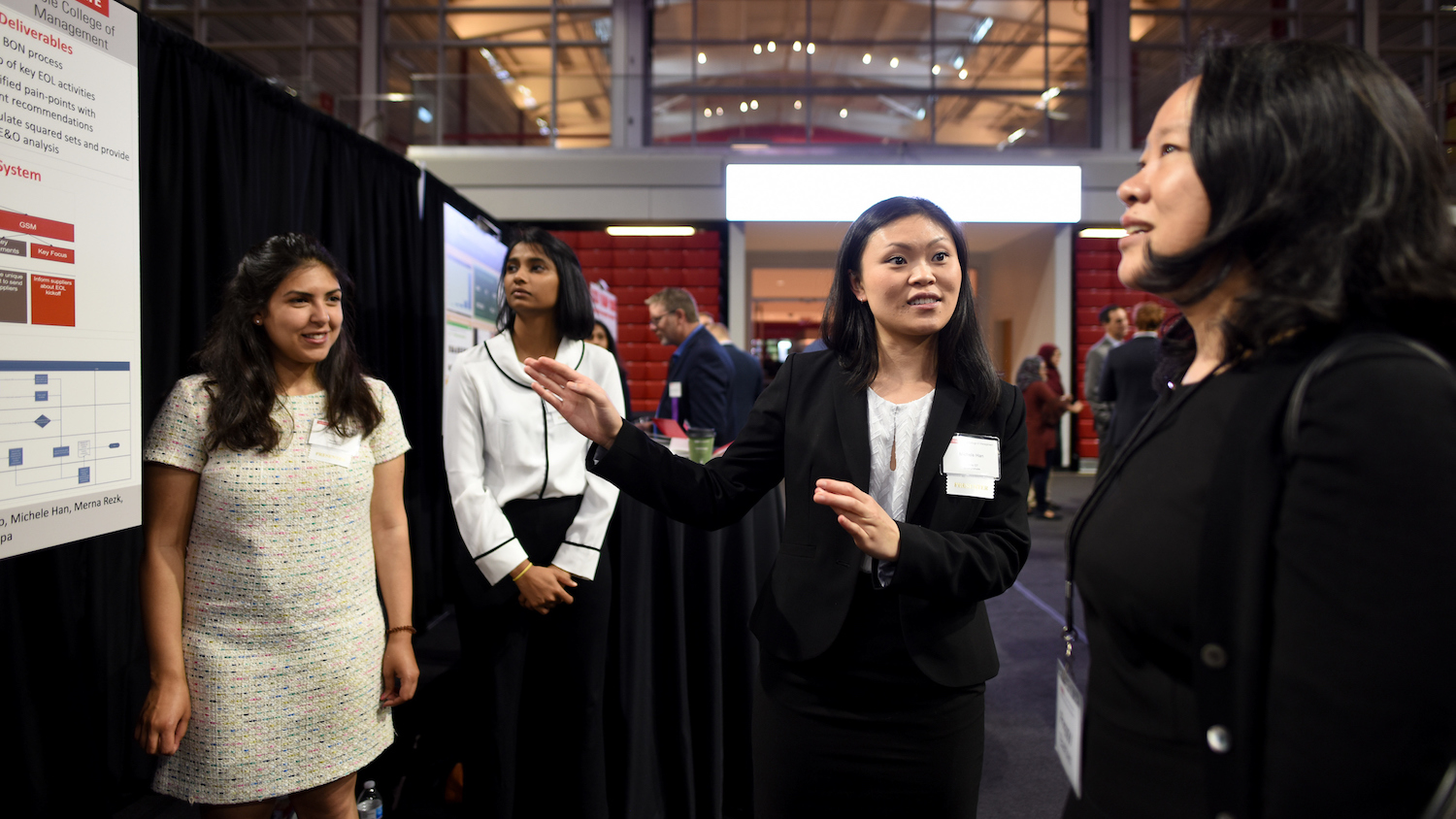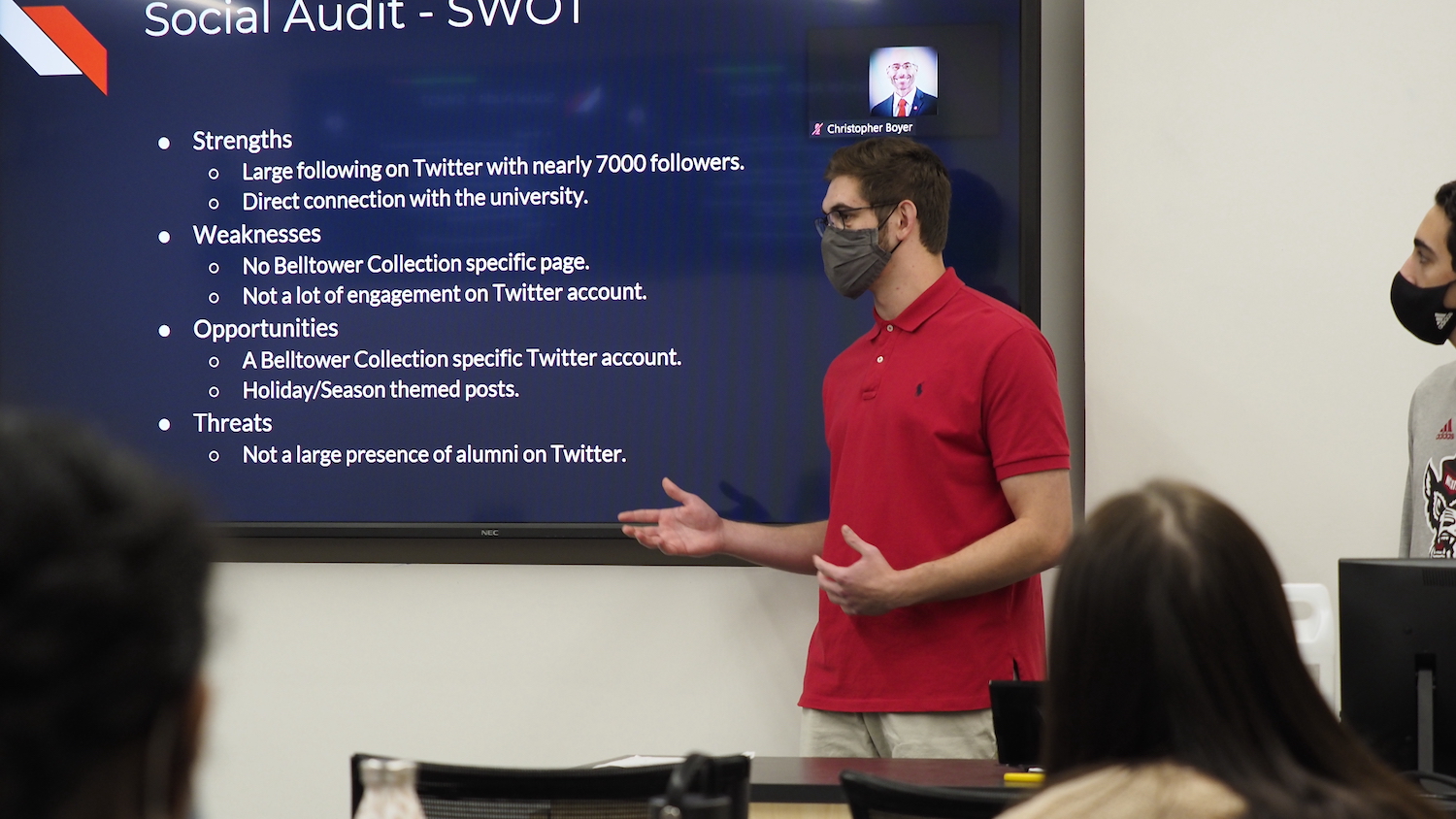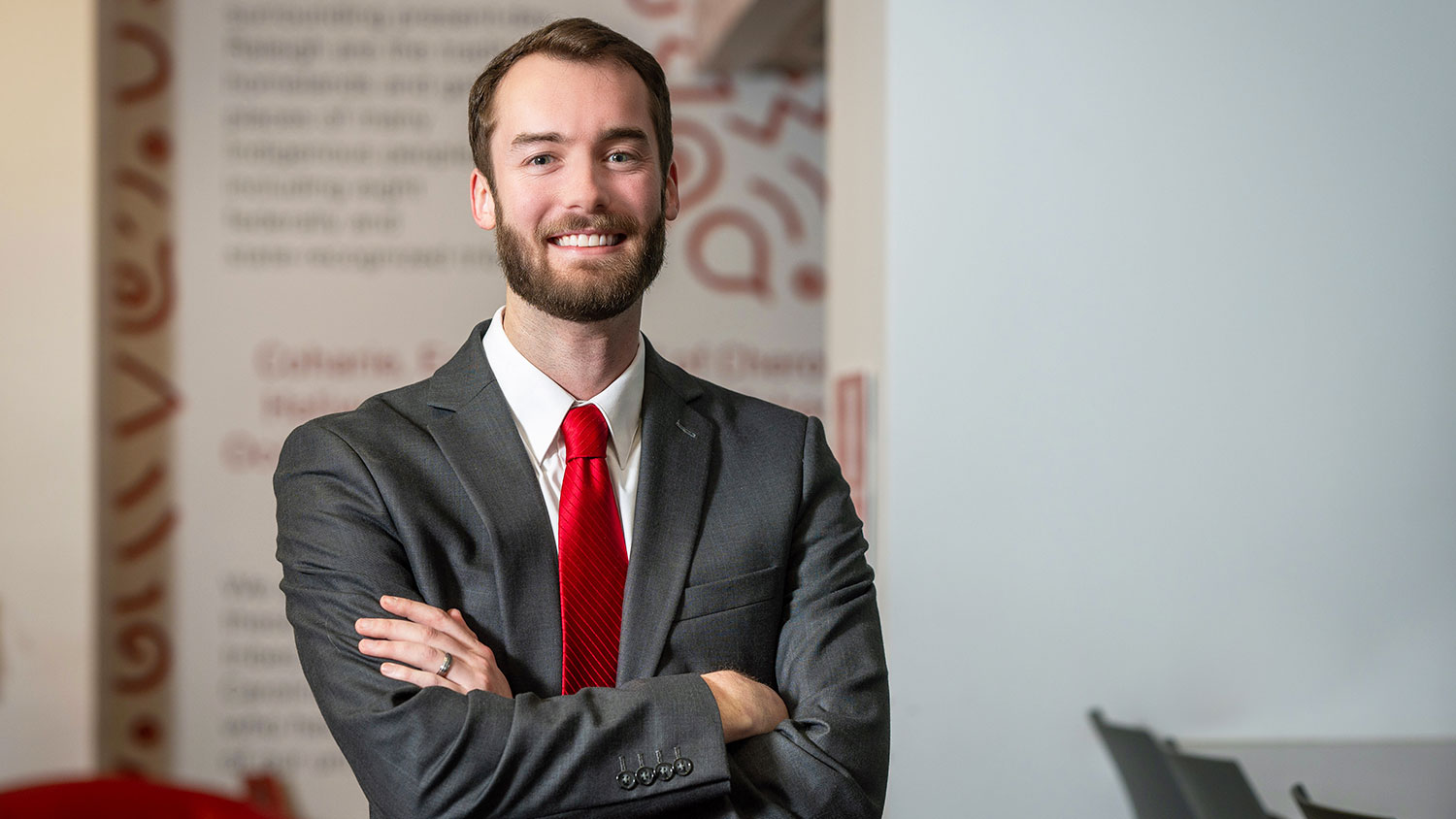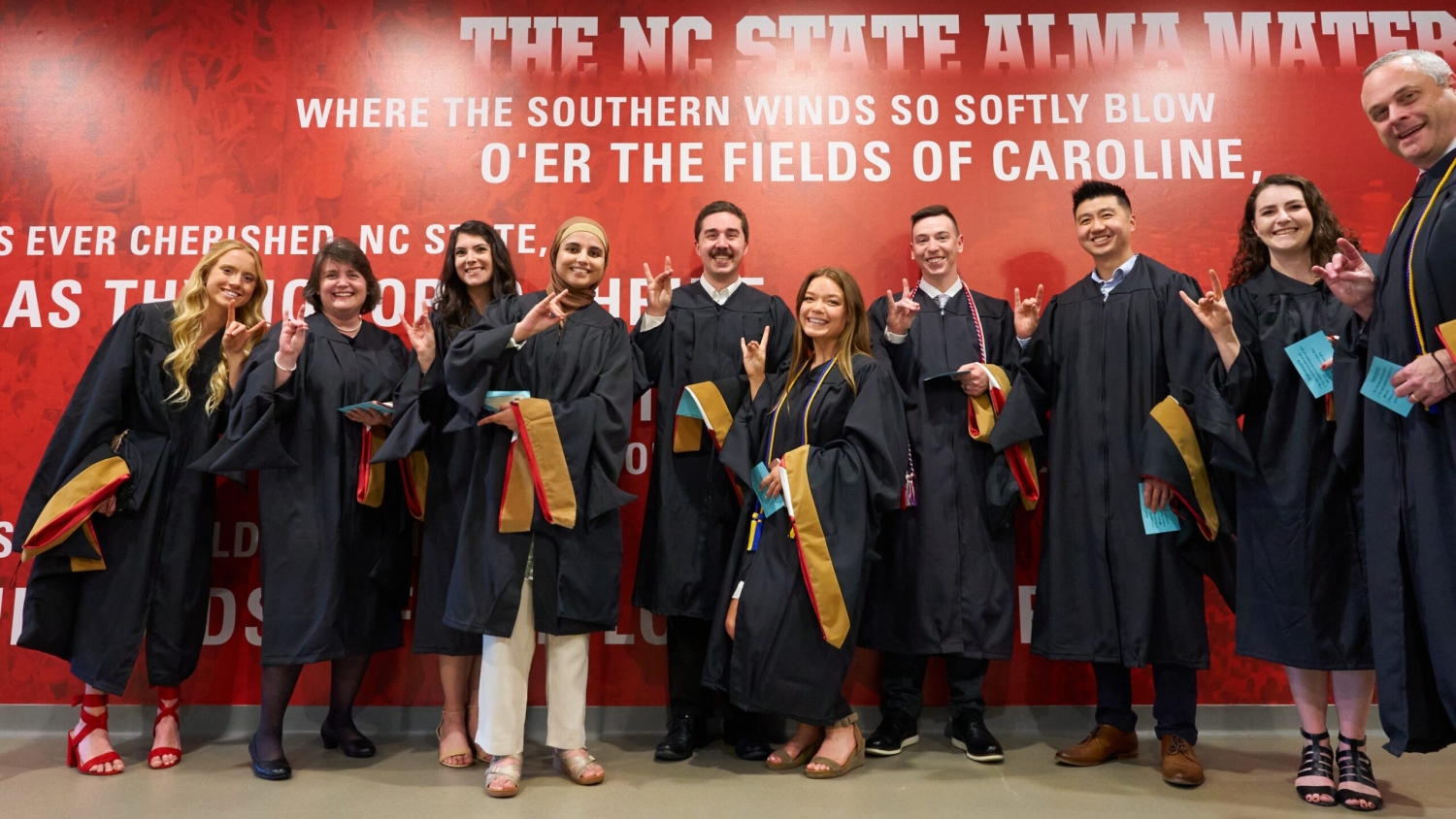Building an Innovative Business Program
When we think about what constitutes a curriculum, it goes beyond simply what is taught within the classroom. Curriculum incorporates the entire learning experience offered by a college or university. Learn more about Poole College’s process for creating a curriculum.

By Caroline Barnhill
When we think about what constitutes a curriculum, it goes beyond simply what is taught within the classroom. Curriculum incorporates the entire learning experience offered by a college or university. In addition to classroom experiences, it can include participation in case competitions, active participation in student groups, engagement with alumni and industry professionals, attending speaker series, supporting faculty in academic research, executive education or even participating in study abroad opportunities.
A lot of time, thought and effort goes into developing an innovative business curriculum that prepares the next generation of business leaders.
To learn more about Poole College’s process for creating a curriculum that meets the needs of its students – and the employers relying on them – we spoke with Vikas Anand, associate dean for academic programs, Scott Showalter, director of the Jenkins Master of Accounting program and professor of practice, and Eileen Taylor, professor of accounting.
Below are their thoughts.
What constitutes “curriculum” at a higher education institution? Can you provide a general overview of the business undergraduate and graduate curriculum?
ET: A curriculum is the group of courses and other academic learning opportunities provided by the university to students. Completing a specific curriculum indicates that a student has met the necessary requirements for earning a degree or certificate. The MBA curriculum, for instance, consists of core courses taken by all MBA students, as well as electives, which are taken in specific groupings. Core courses cover foundational knowledge that all managers should understand, while electives allow students to develop expertise in a specific area such as finance or marketing.
I have always viewed curriculum as serving multiple functions – providing information to students, providing students with the ability to develop critical thinking skills to address issues they will encounter post their graduation, and helping provide students with skills that will be critical to their future success.
VA: I have always viewed curriculum as serving multiple functions – providing information to students, providing students with the ability to develop critical thinking skills to address issues they will encounter post their graduation, and helping provide students with skills that will be critical to their future success. Taken together, the processes should provide the development of internal and external knowledge of the student. Internal knowledge is the knowledge that the students possess in their minds, and have access to through their notes or databases. External knowledge is the knowledge that the student can draw on demand – for instance, knowledge an individual does not personally possess but can obtain by reaching out to a networked individual.
One of the key changes that occurs from the undergraduate to graduate curriculum is the change in the proportions of the functions mentioned above. An undergraduate curriculum tends to be heavier on providing information, whereas graduate curriculum tends to have a stronger emphasis on critical thinking skills and building external knowledge through a greater focus on networking and other activities.
What is a process for curriculum development?
SS: There is not one way for curriculum development. Curriculum development takes place college-wide, department-wide and through individual classes. Major enhancements take a longer period of time and involve feedback from multiple stakeholders. On the other hand, curriculum development also takes place daily by faculty striving to keep the content in their courses current either responding to market trends or informed through academic research.
ET: A college has or develops programs in response to demand. For example, Poole College recognized that students wanted an option to earn an MBA, but couldn’t always attend in person or full time. Also, employers wanted to hire students with an MBA degree. We researched the demand for an online MBA and developed the online MBA program to serve that need. The curriculum (or academic requirements) are developed by faculty who teach in the college. Through benchmarking research and conversations with various stakeholders, faculty determine the skills and knowledge that a graduate of a program should have and list those as program objectives. They then identify existing courses, or develop courses that teach those skills and that knowledge. The curriculum emerges from the process. Curriculum may also change over time, in response to changes in the market. For example, Poole College added sustainability courses and data analytics courses as those topics and skills rose in importance to organizations.
Who are the key stakeholders influencing curriculum development?
VA: There are multiple stakeholders, ranging from the students, faculty, staff and alumni. There are corporate employers who hire our students and parents who may support their children as they navigate through the education system. There are governments that subsidize education or support it through financial aid, and donors and philanthropists who donate to enhance the experience of students by supporting initiatives and establishing scholarships. Ultimately, a good curriculum has to contribute to society by generating the leaders of the future. The existence of such a large number of stakeholders, and the need to satisfy their competing demands, makes curriculum development and management an extremely challenging process.
What trends have you seen in curriculum development in the past five to 10 years?
SS: One trend is to constantly evaluate the curriculum for changes needed to anticipate and meet industry trends. Along with this is the need for speed. With the increasing pace of change in business, the academy needs to be willing to make changes that may not be perfect, but are directionally correct and make adjustments in response to changes in the marketplace. In other words, the curriculum is constantly under some type of enhancement.
With the increasing pace of change in business, the academy needs to be willing to make changes that may not be perfect, but are directionally correct and make adjustments in response to changes in the marketplace.
ET: I believe we are asking more practitioners to weigh in on skills needed by our graduates. We have alternated between providing a strong foundation with pre-determined concentrations and the option of allowing students to “build their own” expertise through the electives they choose.
In your perspective, what are major challenges in curriculum development, and how does Poole/NC State address them?
SS: Striving for perfection often gets in the way of curriculum development. We want to know all the answers before moving forward. Also, some colleges do not take the time to seek outside advice about industry trends. Active advisory boards generally do not allow curriculum to remain dormant. Also, faculty keeping in touch and participating with industry participants helps inform faculty about current trends and what needs to change.
ET: We have a strong faculty who are experts in their fields. This means that we also teach to our strengths. The challenge is that if there are new topics and technologies that are in demand, we can’t just become experts in those fields overnight. So, we can update curriculum, but don’t have the resources to make wholesale changes. Although technology enables students to be more efficient (they can research online versus physically going to the library and manually searching), at the same time, knowledge is growing exponentially, so faculty have to balance teaching students the basic concepts and teaching the students cutting-edge innovations – all without an increase in the number of credit hours. Students also have more demands on their time, often combining work with school so that they can reduce the debt they acquire to earn a degree. Another challenge is the amount of work it takes to create a new program, all with no guarantee that it will be successful or in demand five years from now. We can take risks, but there is a cost involved.
What are the biggest successes you’ve seen at Poole regarding curriculum development?
VA: The students! An extremely motivated and committed student body often leads to stronger learning as students challenge each other and the faculty. Another of our key strengths has been the emphasis on analytics – and the associated experiences students have in analytics. The practicums in business analytics have strongly increased student readiness for demanding careers. We have slowly started ensuring that our curriculum goes beyond providing information – a number of students engage in practicums, study abroads and other key experiences. These are all strengths of the Poole curriculum. Our low, in-state tuition rates provide students with access to outstanding curriculum at a low cost.
We have slowly started ensuring that our curriculum goes beyond providing information – a number of students engage in practicums, study abroads and other key experiences. These are all strengths of the Poole curriculum. Our low, in-state tuition rates provide students with access to outstanding curriculum at a low cost.
SS: Without a doubt, the most significant curriculum development success has been the integration of data analytics throughout the undergraduate and graduate curriculums. This effort was recommended by the numerous college advisory boards and embraced by the faculty and is a great example of how effective, faculty-led curriculum development should work.
Where do you see the college heading in terms of curriculum development in the next few years?
VA: We have several ongoing initiatives in our curriculum development. At the undergraduate level, we are focusing on increasing the signature experiences, such as practicums and research projects, the students go through that lead to stronger application of the information they gain in classes. This also increases the depth of their knowledge in the business curriculum. In the graduate curriculum, we are trying to enhance learning by introducing relevant certificates – for instance we are working on certificates in sustainability, innovation and creativity. We will also continue looking to develop new means of delivering curriculum.
SS: The pace of curriculum development needs to accelerate to anticipate and meet the needs of businesses. In addition to content, the academy needs to explore different ways to deliver the content. We need to continue to move further away from a curriculum based on memorization to a curriculum based on critical thinking. Curriculum also needs to address not only the needs of today’s students but to address the lifelong learning of alumni and other professionals. In today’s ever-changing business world, professionals cannot afford to stop learning. Higher education needs to see that opportunity and develop a mindset of curriculum development to meet those lifelong needs.
- Categories:




